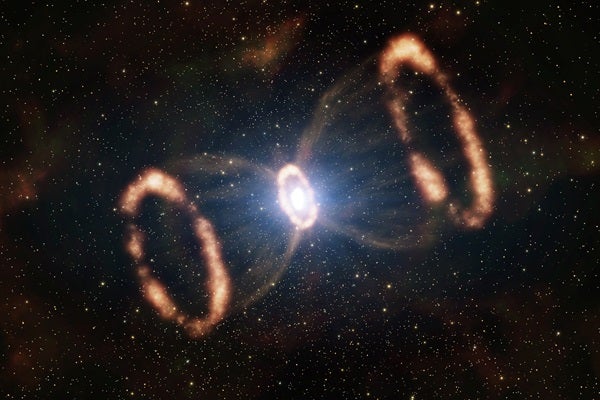In February 1987, a brilliant new point of light shone in the southern sky. This turned out to be the explosive blast marking the death of a star and earned the name Supernova 1987A. Lying just 168,000 light-years from Earth, it is the closest supernova to explode since astronomers developed the tools to study such a blast. And that proximity makes it a perfect laboratory to watch how supernovae evolve. Several discoveries published in 2015 reveal changes to the blast site and uncover secrets of the explosion first seen 28 years ago.
SN 1987A is recognized by its ring of bright nodules, like shining diamonds along a band. These brilliant spots mark where the blast’s shock wave is slamming into previously shed material. While astronomers had seen the diamonds brightening for the past 15 years, new observations show them fading for the first time. This means the blast’s shock wave is passing through the ring of material, breaking it apart. Visible-light observations made by Stockholm University’s Claes Fransson and colleagues using the Hubble Space Telescope show the ring is fading, while spots outside of the ring are beginning to light up. They described the observations in the June 10 issue of The Astrophysical Journal Letters.
X-ray images from the Chandra X-ray Observatory also show the ring’s light changing. David Burrows, who has been watching SN 1987A evolve for 15 years, says the blast’s high-energy light is plateauing.
Another 2015 study focused on SN 1987A’s guts.
When a star at least 10 times the Sun’s mass explodes at the end of its life, the energies, temperatures, and pressures are so high that the supernova produces a range of heavy chemical elements. One of those is titanium-44 (Ti-44), which is an unstable radioactive isotope. “The isotope is produced deep in the core of the explosion, and its properties — mass, ejection speeds, and distribution — directly reflect the physics in the core,” says Steve Boggs of the University of California, Berkeley.
Like all elements, Ti-44 glows with specific colors of light, so if scientists look for those colors, they can learn where that material is. But none of Ti-44’s colors had been visible to astronomers until a recent X-ray telescope, the Nuclear Spectroscopic Telescope Array (NuSTAR), opened its eyes and began collecting data.
Boggs and colleagues described in the May 8 issue of Science their study using NuSTAR to map Ti-44 in SN 1987A. The element’s distribution is clumpy and uneven, implying that the explosion was off-center. This is the second supernova remnant the team has been able to probe; the other is Cassiopeia A. Both explosions were asymmetrical, Boggs’ team says, which means now astronomers have to rethink the theoretical models of these blasts.
Most computer models have assumed a symmetrical blast, but the new studies prove something more complex is happening.










